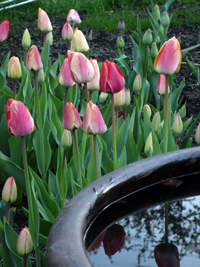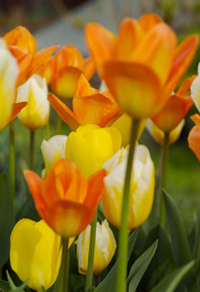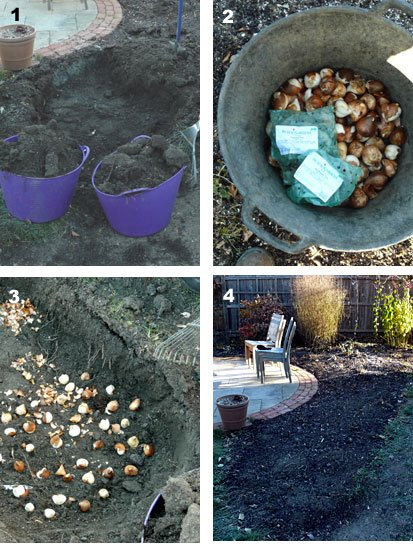






When I started working at Gardener's Supply in the 1990s, my Vermont backyard was pretty green—with grass. Today, there's just a tiny bit of the original lawn left. Most of the available space has given way to trees, shrubs, perennials, annuals and stonework. Watch a slideshow of my garden in Burlington, VT.
In addition to my work at Gardener's Supply, I work in the gardening division at Church Hill Landscapes. In that role, I maintain dozens of gardens and learn a lot in the process. I believe that all gardening is good gardening.

Gudoshnik tulips

Emperor (or Fosteriana) tulips are reliable repeaters. This planting features three varieties.
Here's the thing about tulips: You need to plant a lot of them to make a beautiful display. Think dozens, not handfuls. Come spring, you'll be delighted, especially if you live in a climate where winter lingers too long.
In my small garden, I plant at least 500 tulips every fall. After they bloom, I pull them up to make way for summer annuals.
Here's the other thing about tulips: They're best the first year. In subsequent years, the show diminishes. It's no surprise. Tulip bulbs want cool, moist springs and hot, dry summers, which is not what they get in most parts of the country. Yes, there are perennial tulips and species tulips that return reliably for many years. Stick with those if you don't want to recreate your display every year.
But, if you're up for some fun, find some space in your garden and start shopping for tulips. It might sound like a lot of work, but mass plantings are fairly simple. Here's how you do it:
Figure out where your drifts are going to be. I try to make each drift 2-4 square feet. In my garden, there are several areas that get planted with annuals, so these make ideal spots for drifts of tulips. Just as the tulip display ends, it's time for the annuals to be planted. I also plant a few drifts at the back of the perennial border. The flowers are visible in spring, but, when the post-bloom tulip foliage starts to get ugly, the perennials block it out. These drifts are often made up of perennial tulips, and they thrive happily for years and years.
Buy bulbs based on the square footage you have to cover. I plant 15-25 bulbs per square foot, which means they are pretty close together. You can be more thrifty and plant them further apart, but I think the tight spacing ensures that the drift will look bold and abundant.
For each drift, dig a planting trench that's 6-8" deep. Keep in mind that a curved shape will be more natural-looking. When you see the volume of soil that comes out, it might feel more like you're doing an excavation than gardening. True, but it's the most efficient way to get the bulbs close together. Tip: shovel the excavated soil into a wheelbarrow or Tubtrugs; it's so much easier to backfill the trench.
Once the trench is dug, pour in the bulbs. Arrange them randomly, pointy end up. To create a natural-looking drift, avoid positioning the bulbs in precise rows. Pour the excavated soil back into the trench, rake it smooth and pack it down by walking on the planting area.

1. Dig a trench, saving the soil in wheelbarrows and or tubs (for easy backfilling).
2. If using more than one color, mix the bulbs in a tub to ensure random distribution of color.
3. Position the bulbs 3-4" apart, pointy side up.
4. Backfill with soil, rake smooth and pack lightly by walking on the surface.
Copyright © www.100flowers.win Botanic Garden All Rights Reserved